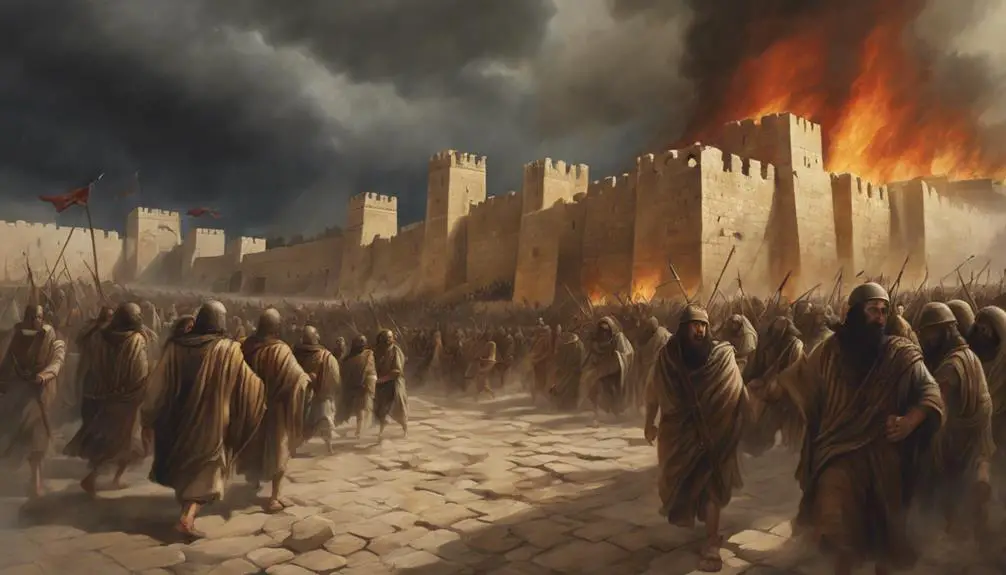Gain insights into the dramatic fall of biblical Israel, exploring causes and consequences that still echo in modern lessons on leadership and faith.

The Fall of Israel in the Bible
Have you ever wondered why the once-great kingdom of Israel fell, as narrated in the Bible?
You're about to step into a journey through time, where prosperity blooms and fades, kingdoms split, and prophets rise with urgent warnings.
The Assyrian exile and the Babylonian captivity mark key points in this narrative, each with lessons that resonate through history.
As we explore these pivotal events, consider what they reveal about leadership, faith, and the consequences of turning away from guiding principles.
Stay with us to uncover the deeper meanings behind these ancient stories and their relevance today.
Key Takeaways
- The fall of Israel was precipitated by internal divisions and moral decay.
- Prophetic warnings of decline were ignored, exacerbating the nation's downfall.
- Exile served as a crucible for spiritual reflection and identity reaffirmation.
- Lessons from the fall and exile emphasize the importance of humility and faithfulness to God.
The Era of Prosperity

Before the fall, Israel experienced an era of prosperity, marked by significant economic, political, and cultural achievements that shaped its legacy in ancient history. Central to this period was the reign of Solomon, whose wisdom not only brought peace but also unparalleled wealth to the nation. Solomon's discernment in governance, as well as his diplomatic engagements with neighboring states, played a pivotal role in establishing Israel as a formidable power in the region.
A testament to this golden age was the construction of the Temple, an architectural marvel that symbolized not just the religious fervor of the time but also the zenith of Israelite craftsmanship and artistry. The Temple's completion under Solomon's reign wasn't merely an act of religious devotion; it was a statement of political strength and cultural sophistication. Through the Temple's construction, Solomon managed to unite a diverse populace under a shared identity, fortifying the nation's internal cohesion and its standing among ancient civilizations.
This era of prosperity, therefore, wasn't an accident of history but a carefully orchestrated period, driven by Solomon's strategic vision and his unparalleled wisdom. These achievements laid the groundwork for Israel's prominence, leaving a legacy that would endure well beyond its eventual decline.
The Split of the Kingdom

The split of the kingdom, a pivotal event in Israel's history, marked the end of its united and prosperous era, ushering in a period of division and decline. This division wasn't just political; it was a profound transformation that affected every aspect of life in the once-unified kingdom. You're looking at a moment that fundamentally altered the course of Israel's history, setting the stage for a complex narrative of conflict, faith, and identity.
Three critical factors contributed to this split:
- Rehoboam's folly: His decision to reject wise counsel and impose harsher conditions on the northern tribes epitomized the lack of discernment that ultimately led to the kingdom's division.
- Jeroboam's idolatry: In an attempt to consolidate his rule over the northern kingdom, Jeroboam introduced idol worship, setting a precedent for religious practices that diverged significantly from those of the south.
- Political and social unrest: The split wasn't merely the result of individual decisions but was also fueled by underlying tensions and dissatisfaction among the tribes.
Analyzing these elements, you grasp the complexity of the split. Rehoboam's folly and Jeroboam's idolatry weren't just personal failings; they were symptomatic of deeper issues within the kingdom.
Rise of Prophetic Warnings

Amidst the turmoil following the kingdom's split, prophets emerged as divine messengers, warning Israel and Judah of the consequences of their actions and urging a return to covenantal faithfulness. These figures, chosen by the divine, played pivotal roles, acting as intermediaries between the divine realm and a society marked by complacency and deviation from spiritual and moral standards. Their emergence wasn't coincidental but a direct response to the people's straying from the path prescribed in their covenant with the divine.
The prophets' warnings were characterized by vivid imagery and stern admonitions, aiming to shake the populace out of their societal complacency. They spoke of divine interventions as both imminent threats and opportunities for redemption, provided there was a collective return to the principles that once guided the nation. The prophets didn't mince words; they laid bare the consequences of continued neglect of divine commandments, emphasizing that the path to prosperity and security lay in adherence to these tenets.
Their messages, though often met with resistance, were crucial. They served as a reminder that societal well-being was intricately tied to spiritual and ethical living, underlining a profound truth: neglect divine warnings, and face inevitable decline.
Assyrian Exile

In an era marked by defiance and spiritual waywardness, Assyrian exile emerged as a pivotal consequence for Israel's disregard of prophetic warnings. The Assyrians, known for their ruthless military strategies and psychological warfare, employed several tactics that not only decimated the northern kingdom of Israel but also aimed to obliterate its cultural and spiritual identity. This period serves as a critical examination of Hebrew resilience in the face of overwhelming adversity.
The narrative of the Assyrian exile unfolds through a series of strategic moves:
- Territorial fragmentation: The Assyrians systematically dismantled the socio-political structures of Israel, dividing the kingdom into smaller, manageable provinces. This fragmentation weakened national unity and disrupted the communal worship practices central to Hebrew identity.
- Forced migrations: Populations were relocated en masse, a tactic designed to dilute national identities and assimilate conquered peoples into the Assyrian empire. Despite these efforts to erase their heritage, many Hebrews clung tenaciously to their traditions and faith.
- Cultural imposition: The Assyrians introduced their gods and customs into the conquered territories, aiming to supplant the local religious practices. Yet, the Hebrews' resilience in maintaining their cultural and spiritual practices amidst persecution highlighted their enduring faith and identity.
The Assyrian exile, therefore, wasn't merely a historical event; it was a testament to the Hebrews' profound resilience against Assyrian tactics designed to eradicate their identity.
Babylonian Captivity

Following the Assyrian exile, another pivotal chapter unfolded as Babylon emerged as the new power, leading to the Babylonian Captivity, a period marking profound challenges and transformations for the Hebrew people. Under Nebuchadnezzar's reign, this era was characterized by significant upheaval and distress for the Jewish community. You'll find that Nebuchadnezzar didn't merely conquer; his actions led to a deep, cultural rupture within the Hebrew society.
This period, notably marked by the Temple plunder in 586 BCE, wasn't just a physical destruction but a profound spiritual crisis. The Temple's plunder under Nebuchadnezzar was a calculated move to undermine the Hebrews' religious and societal foundations. It's crucial to understand that the Temple was more than a place of worship; it was the symbol of the Hebrews' covenant with God, a center of their community and faith.
The Babylonian Captivity forced the Hebrew people into exile, stripping them of their land, temple, and, seemingly, their identity. Yet, it's within this context of loss and displacement that you observe a significant transformation. The Hebrews' resilience in maintaining their faith and identity, despite these adversities, underscores the period's complexity. The Babylonian Captivity, therefore, wasn't just a time of suffering but also a pivotal moment of adaptation and perseverance.
Lessons Learned

The Babylonian Captivity, while a period of profound loss, taught the Hebrews invaluable lessons about resilience, faith, and the essence of their identity. This tumultuous era underscored the critical nature of their covenant with God, revealing depths of understanding about divine expectations and human frailty. Analyzing this period reveals several key lessons:
- Divine Humility: The Hebrews learned the importance of humility before God. Their downfall was a stark reminder that prosperity and divine favor weren't entitlements but conditional upon their adherence to God's laws. This period reinforced the concept that humility and repentance were necessary for redemption.
- The Dangers of Moral Decay: The captivity served as a vivid illustration of the consequences of moral decay within a society. It underscored the idea that ethical and moral lapses, particularly idolatry and injustice, could lead to societal downfall, highlighting the need for a steadfast commitment to righteousness.
- The Essence of Identity: Lastly, the exile crystallized the understanding of their identity not just as a nation, but as a community of faith. Stripped of their temple and homeland, the Hebrews found that their true identity and strength lay in their faith and in the practice of their traditions, even in the face of displacement.
These lessons, born from a period of hardship, shaped the Hebrews' journey towards rebuilding and renewal, offering timeless insights into the nature of resilience, faith, and identity.
Frequently Asked Questions
How Did the Architectural and Cultural Landscape of Israel Change After the Babylonian Captivity?
After the Babylonian captivity, you'd notice significant changes in Israel's architectural and cultural landscape. Roman influence introduced new building techniques and styles, reshaping cities and infrastructure.
Later, the Islamic conquest further diversified the cultural tapestry, introducing Islamic architectural elements and traditions. These epochs layered upon each other, creating a complex blend of influences that you can still see in the region today, reflecting a rich historical narrative of conquests and cultural exchanges.
What Were the Long-Term Impacts of the Fall of Israel on the Neighboring Nations' Politics and Alliances?
You might think the fall of a single nation wouldn't ripple far, but you'd be surprised.
The long-term impacts on neighboring nations' politics and alliances were profound. Trade disruptions halted the flow of goods, leading to economic downturns. Diplomatic realignments shifted power balances, as countries scrambled to fill the void left by Israel's decline.
This reshaped the regional map, influencing relationships and power dynamics for generations. It's a classic example of the butterfly effect in history.
In What Ways Did the Fall of Israel Influence the Development of Jewish Religious Practices and Beliefs?
You'll find that the fall significantly influenced Jewish religious practices and beliefs. Synagogue formation and prayer evolution emerged as pivotal adaptations.
With the loss of a centralized worship location, synagogues became crucial for community and spiritual life. Prayer practices evolved to maintain a connection with God, adapting to the diaspora's challenges.
These developments reflect a resilient adaptation to maintain identity and faith amidst profound change, showcasing an enduring spiritual and communal innovation.
How Did the Economies of Israel and Judah Compare Before the Split, and What Were the Economic Consequences of Their Falls?
Before their split, Israel and Judah were two peas in a pod economically, benefitting from robust agricultural techniques and bustling trade routes. However, their economic landscapes diverged post-split.
Israel expanded trade, while Judah focused on agriculture. The falls of these nations not only shattered their economies but also rerouted trade pathways and agricultural advancements.
You'd see a significant shift in economic stability, influencing the broader region's commerce and agricultural practices.
Can the Fall of Israel Be Seen in Any Archaeological Findings Outside of the Biblical Narrative, and What Do These Findings Tell Us?
Yes, you can find evidence of Israel's fall in archaeological discoveries outside the biblical narrative. These findings, including shifts in climate impact and changes in trade routes, give us a broader picture.
They show how environmental changes and economic shifts played a significant role. By examining pottery, inscriptions, and settlement patterns, you'll see how these factors contributed to the societal changes and eventual downfall of ancient Israel.
Conclusion
As you've journeyed through the tumultuous history of Israel, from its zenith of prosperity to its nadir in exile, it's clear that the nation's trajectory serves as a potent allegory for the cyclical nature of human fortune.
The Assyrian and Babylonian captivities weren't merely historical footnotes; they were the crucibles in which the resilient spirit and identity of a people were forged.
This saga, rich in prophetic warnings, underscores the perennial wisdom that from the ashes of downfall, renewal is born.



Sign up